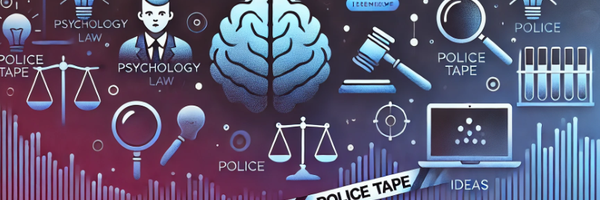Teen Minds and Crime
Grade 9
Presentation
No video provided
Problem
Youth crime is a growing concern in Canada, Some might not find it a pressing issue, but its gradual upbringing has been corrupting our future generations. Statistics Canada stated that the youth crime rate per 100,000 population increased by 12.7% in 2023. Alongside it, the Violent Crime Severity Index for youth increased by 0.4%, with the Non-Violent Crime Severity Index increased by 3.1% in that same year.
Specifically, Calgary is sharing its own set of dangers, where there has been an uptick in criminal activity among adolescents. The top offences of youth include Theft, Property Crime, Assault, Robbery, Illegal Weapon Possession and Sexual Offenses, the highest of them all featuring 789 reported incidents in 2023. Disorderly Conduct reports have also significantly increased in 2023 by 15%, featuring crimes such as intoxication, public fights, and obstructive behaviour. Overall, some studies show that the hate crime incidents reported to the police have increased by 72% since 2019 and over 90% of sexual assaults are not reported to the police.
Teenagers are in a critical developmental stage where the brain’s prefrontal cortex (the area responsible for impulse control and decision-making) is not fully developed. This biological factor makes them more prone to impulsivity, peer influence, and risky behaviour. The consequences of youth crime extend beyond the immediate actions of individuals. They grasp multiple issues such as economic costs for society, social disruption and putting their future at risk.
The central solution to comprehending youth crime and preventing it is the underlying thinking process. The psychological factors behind these behaviors such as a lack of empathy, impulsivity, and vulnerability to peer influence are not often fully explored in local studies. Understanding these psychological aspects is essential for creating effective prevention strategies and promoting safer communities. This project seeks to explore teenagers' attitudes toward crime from psychological and sociological perspectives, aiming to uncover valuable insights into the root causes of youth crime and detecting correlations that could pinpoint certain flaws.
Method
The Question: How do psychological traits such as empathy, impulsivity, social vulnerability and moral reasoning influence teenagers' attitudes toward crime in Calgary?
After a long period of extensive background research, the core of my research project revolved around a Google Form Managed Survey- a developed questionnaire set to test these various psychological traits as well as correlating them to their views on crime. The goal was to understand if there were any underlying patterns in teenage behaviour that could explain the crimes that happen.
Survey Outline
Part 1: Demographics: Do age, gender and social media habits play any role in influencing these justifications?
What is your Age? (12-17)
What is your gender? (Male or Female)
Which Social Media do you access? (Select all that apply)
How many hours do you use social media a day? (Ranges)
Purpose: How do the psychological differences of Age and Gender alter perceptions of criminal activity?
Part 2: Empathy Measuring emotional sympathy and understanding how it correlates to criminal justification. Being able to put yourself in someone else's position is a key psychological trait in decision making.
Method: Use Likert Scales for certain scenarios that will show their sense of empathy. Explore cognitive empathy, emotional empathy and emotional sympathy.
(Likert Scale: Strongly Disagree, Disagree, Neutral, Agree, Strongly Agree)
“I feel upset when I see someone going through something difficult"
"I find it hard to understand other people's feelings, especially when I don't relate to them"
"I get a strong urge to help when I see someone who is upset or less fortunate than me"
Purpose: This data will help identify if a lack of empathy means an increase in the justification of crimes. Teenagers who score low on empathy might be able to justify bad actions, whereas those with stronger empathy might not.
Part 3: Morality: The ability to discern right from wrong is known as your morality. This one is crucial.
Method: Research the concepts of Utilitarian and Deontoloigcal Moralities and base questions off of them
Purpose: Not only does this give us a grasp of what modern day youth considers to be right and wrong, but goes to show that those with a certain morality might tend to justify and allow crimes to happen. This also begs to question what crimes should be addressed and perhaps what altercations in policymaking need to happen.
Part 4: Impulsivity: The tendency to act without fully considering the consequences is known as Impulsivity, something quite common in teenagers- but how impactful is impulsivity in relation to youth crime? Understanding how impulsivity influences decision-making in teenagers could shed light on why certain teens engage in crimes, particularly those that are spontaneous or unplanned, such as vandalism or theft.
Method: Use Likert Scales for certain scenarios that will analyze impulsivity in teenagers.
"I struggle to resist things I desire in the moment."
"I often act without fully considering the short- and long-term consequences"
" If an idea excites me, I’ll jump into it without much planning"
Purpose: Will highly impulsive teenagers rationalize crimes due to the lack of consideration for long term consequences? This is simply a part of the project, meaning if teenagers tend to have high impulsivity and susceptibility to peer pressure, it could lead to the rationalization of crime. It is correlation, not causation.
Part 5: Conformity/Peer Pressure: This aim measures the desperate need for social approval and the desire to please others and how it correlates to their views on crime.Are teenagers more likely to act differently towards a crime if their friends approve of it/it is the easier way out? How strong is that variable in manipulating their choices?
Part 6: Attitudes Towards Crime
The first half was psychological traits, the second half is their views on crime. I will connect this half with the other half to figure out the connections.
" It is okay to commit a crime if it really helps your loved ones"
"Theft is justifiable if someone is starving"
"It’s easier to justify breaking the law if I’m not acting alone"
Is there such thing as a "victimless crime?" (an illegal act that does not directly harm another person or their property because all parties involved consent to the act)
"Stealing from an individual is worse than stealing from a large company"
"Minor crimes do not need punishment" (Ex: Speeding, Trespassing, Loitering)
"If a close friend broke a law, I would report them"
Research
-
Section: YCJ (youth justice committees, her professional opinion on causes, solutions, and the effectiveness of understanding psychological traits.
The Calgary Youth Justice Committee is an authorized organization as an alternative to court that is centered on rehabilitating youth. Their most popular crimes of 2024 was Theft under $5,000, Assault, Sexual Assault, Robbery, Mischief and Possession of a weapon.
Specialist Courtney Bailey mentioned mental health being a core cause in youth crime in Calgary. “anxiety, depression, self harm, learning disabilities, FASD and bullying” Social Media was also a root cause and what we see in our daily lives and what is normalized on social media.
She feels the biggest misconception that youth have is not understanding what is acceptable and what isn’t. (When working with sex offenders, they have to educate them on what consent truly is and what it means to say no)
The biggest misconception about the youth justice system in her opinion is believing youth should be locked up after one mistake instead of reeducated.
When asked about potential demographic impacts: Gender is a big one that I have seen and learn more about over the years, when i worked in corrections specifically for youth there was always way less females than males.
-
Some Statistics..
Child Pornography: There was a significant 52% increase in police-reported child pornography incidents in 2023, making it a major contributor to the rise in the overall CSI. This category accounted for approximately 5% of the overall CSI value
Fraud and Extortion: The rate of fraud offenses increased by 12% in 2023, while extortion cases saw a 35% rise, indicating a growing involvement of youth in these crimes.
2023 = 975 Youth Offenders in two quarter (6 months)
2024 = 1981 Youth Crimes
Most Common Youth Crimes: Assault and Fraud
2022, Quarter 4: Total Youth Crime = 217
2023, Quarter 4: Total Youth Crime = 516
2022, Quarter 4: Total Youth Crime = 23
2023, Quarter 4: Total Youth Crime = 131
Survey Based Research
84.50% = High Empathy (109 Kids)
15.50% = Low Empathy (20 Kids)
51.6% = High Impulsivity (66 Kids)
48.84% = Low Impulsivity (63 Kids)
75.19% = Utilitarian Morality (78 Kids)
24.81% = Deontological Morality (56 Kids)
53.49% = Unaffected by Social Influence (69 Kids)
46.51% = Affected by Social Influence (60 Kids)
38.78% = Justifying Crimes for Loved Ones (50 Kids)
61.24% = Do Not Justify Crimes for Loved Ones (79 Kids)
56.59% = Justify Theft in Dire Situations (73 Kids)
43.41% = Do not justify theft in dire situations (56 Kids)
75.19% = Do not think it is easier to justify a crime in a group (97 Kids)
24.18% = Think it is easier to justify a crime in a group (32 Kids)
51.6% = Do not believe in victimless crimes (66 Kids)
48.84% = Believe in Victimless Crimes (63 Kids)
59.59% = Believe stealing from an individual is worse than a corporation (77 Kids)
40.31% = Believe Theft is Theft, no matter the victim. (52 Kids)
70.54% = Minor Crimes Still Need Punishment (91 Kids)
29.46% = Minor Crimes Do Not Need Punishment (38 Kids)
74.42% = Prioritize Loyalty over Law (96 Kids)
25.58% = Prioritize Law over Loyalty (33 Kids)
Impulsivity
“It is okay to commit a crime if it serves your loved ones”
High Impulsivity Individuals who Justify Crimes for Loved Ones = 32 Kids (48.48% of High Impulsivity individuals)
High Impulsivity Individuals who Do Not Justify Crimes for Loved Ones = 34 Kids (51.52% of High Impulsivity Individuals)
Low Impulsivity Individuals who Justify Crimes for Loved Ones = 18 Kids (28.75% from Low Impulsivity Individuals)
Low Impulsivity Individuals who Do Not Justify Crimes for Loved Ones = 45 Kids (71.43% of the Low Impulsivity Individuals)
“Theft is Justifiable if someone is starving”
High Impulsivity Individuals who Justify Theft in Dire Situations = 41 Kids (62.12% of High Impulsivity individuals)
High Impulsivity Individuals who Do Not Justify Theft in Dire Situation = 25 Kids (37.88% of High Impulsivity Individuals)
Low Impulsivity Individuals who Justify Theft in Dire Situations = 32 Kids (50.79% from Low Impulsivity Individuals)
Low Impulsivity Individuals who Do Not Justify Theft in Dire Situation = 31 Kids (49.21% of the Low Impulsivity Individuals)
"It’s easier to justify breaking the law if I’m not acting alone"
High Impulsivity Individuals who Believe It is easier to commit crimes in groups = 41 Kids (27.27% of High Impulsivity individuals)
High Impulsivity Individuals who Believe Groups Don’t Change the Justification of Crime = 18 Kids (72.73% of High Impulsivity Individuals)
Low Impulsivity Individuals who Believe It is easier to commit crimes in groups = 14 Kids (22.32% from Low Impulsivity Individuals)
Low Impulsivity Individuals who Believe Groups Don’t Change the Justification of Crime = 49 Kids (77.78% of the Low Impulsivity Individuals)
“Do you believe in Victimless Crimes?”
High Impulsivity Individuals who do not believe in Victimless Crimes = 34 Kids (51.54% of High Impulsivity individuals)
High Impulsivity Individuals who believe in Victimless Crimes = 32 Kids (51.52% of High Impulsivity Individuals)
Low Impulsivity Individuals who do not believe in Victimless Crimes = 32 Kids (50.79% from Low Impulsivity Individuals)
Low Impulsivity Individuals who believe in Victimless Crimes = 31 Kids (49.21% of the Low Impulsivity Individuals)
“Is stealing from an individual worse than stealing from a corporation?”
High Impulsivity Individuals who believe Theft is Theft, no matter the victim. = 26 Kids (39.39% of High Impulsivity individuals)
High Impulsivity Individuals who believe stealing from an individual is worse than stealing from a corporation = 40 Kids (60.61% of High Impulsivity Individuals)
Low Impulsivity Individuals who believe Theft is Theft, no matter the victim. = 26 Kids (41.27% from Low Impulsivity Individuals)
Low Impulsivity Individuals who believe stealing from an individual is worse than stealing from a corporation = 37 Kids (58.73% of the Low Impulsivity Individuals)
"Minor crimes do not need punishment" (Ex: Speeding, Trespassing, Loitering)
High Impulsivity Individuals who believe Minor Crimes still need punishment. = 50 Kids (75.76% of High Impulsivity individuals)
High Impulsivity Individuals who believe Minor Crimes do not need punishment = 16 Kids (24.24% of High Impulsivity Individuals)
Low Impulsivity Individuals who believe Minor Crimes still need punishment. = 41 Kids (65.08% from Low Impulsivity Individuals)
Low Impulsivity Individuals who believe Minor Crimes do not need punishment = 22 Kids (34.92% of the Low Impulsivity Individuals)
"If a close friend broke a law, I would report them"
High Impulsivity Individuals who put Loyalty over Law = 46 Kids (69.70% of High Impulsivity individuals)
High Impulsivity Individuals who put Law over Loyalty = 20 Kids (30.30% of High Impulsivity Individuals)
Low Impulsivity Individuals who put Loyalty over Law. = 50 Kids (79.37% from Low Impulsivity Individuals)
Low Impulsivity Individuals who put Law over Loyalty = 13 Kids (20.63% of the Low Impulsivity Individuals)
Empathy
“It is okay to commit a crime if it serves your loved ones”
High Empathy Individuals who Justify Crimes for Loved Ones = 37 Kids (33.94% of High Empathy individuals)
High Empathy Individuals who Do Not Justify Crimes for Loved Ones = 72 Kids (66.06% of High Empathy Individuals)
Low Empathy Individuals who Justify Crimes for Loved Ones = 7 Kids (35% from Low Empathy Individuals)
Low Empathy Individuals who Do Not Justify Crimes for Loved Ones = 13 Kids (65% of the Low Empathy Individuals)
“Theft is Justifiable if someone is starving”
High Empathy Individuals who Justify Theft in Dire Situations = 67 Kids (61.74% of High Empathy individuals)
High Empathy Individuals who Do No Justify Theft in Dire Situations = 42 Kids (38.53% of High Empathy Individuals)
Low Empathy Individuals who Justify Theft in Dire Situations = 8 Kids (40% from Low Empathy Individuals)
Low Empathy Individuals who Do Not Justify Theft in Dire Situations = 12 Kids (60% of the Low Empathy Individuals)
"It’s easier to justify breaking the law if I’m not acting alone"
High Empathy Individuals who find it easier to break laws in groups= 28 Kids (25.69% of High Empathy individuals)
High Empathy Individuals who believe Groups Don’t Change the Justification of Crime = 81 Kids (74.31% of High Empathy Individuals)
Low Empathy Individuals who find it easier to break laws in group = 7 Kids (35% from Low Empathy Individuals)
Low Empathy Individuals who believe Groups Don’t Change the Justification of Crime = 13 Kids (65% of the Low Empathy Individuals)
“Do you believe in Victimless Crimes?”
High Empathy Individuals who do not believe in Victimless Crimes = 59 Kids (54.13% of High Empathy individuals)
High Empathy Individuals who believe in Victimless Crimes = 50 Kids (45.87% of High Empathy Individuals)
Low Empathy Individuals who do not believe in Victimless Crimes = 10 Kids (50% from Low Empathy Individuals)
Low Empathy Individuals who believe in Victimless Crimes = 10 Kids (50% of the Low Empathy Individuals)
“Is stealing from an individual worse than stealing from a corporation?”
High Empathy Individuals who believe Theft is Theft, no matter the victim. = 39 Kids (35.78% of High Impulsivity individuals)
High Empathy Individuals who believe stealing from an individual is worse than stealing from a corporation = 70 Kids (64.22% of High Empathy Individuals)
Low Empathy Individuals who believe Theft is Theft, no matter the victim. = 5 Kids 25% from Low Empathy Individuals)
Low Empathy Individuals who believe stealing from an individual is worse than stealing from a corporation = 15 Kids (75% of the Low Empathy Individuals)
"Minor crimes do not need punishment" (Ex: Speeding, Trespassing, Loitering)
High Empathy Individuals who believe Minor Crimes still need punishment. = 71 Kids (65.14% of High Empathy individuals)
High Empathy Individuals who believe Minor Crimes do not need punishment = 38 Kids (34.86% of High Empathy Individuals)
Low Empathy Individuals who believe Minor Crimes still need punishment. = 16 Kids 80% from Low Empathy Individuals)
Low Empathy Individuals who believe Minor Crimes do not need punishment = 4 Kids (20% of the Low Empathy Individuals)
"If a close friend broke a law, I would report them"
High Empathy Individuals who put Loyalty over Law = 73 Kids (67% of High Empathy individuals)
High Empathy Individuals who put Law over Loyalty = 36 Kids (33.03% of High Empathy Individuals)
Low Empathy Individuals who put Loyalty over Law. = 10 Kids (50% from Low Empathy Individuals)
Low Empathy Individuals who put Law over Loyalty = 10 Kids (50% of the Low Empathy Individuals)
Moral Reasoning
“It is okay to commit a crime if it serves your loved ones”
Utilitarian, Doesn’t Justify Crime for Loved Ones = 74 Kids (81.32% of Utilitarians)
Utilitarian, Justifies Crime for Loved Ones = 23 Kids (25.27% of Utilitarians)
Deontological, Does Not Justify Crime for Loved Ones = 24 Kids (75% of Deontological)
Deontological, Justifies Crimes for Loved Ones = 8 Kids (25% of Deontological)
“Theft is Justifiable if someone is starving”
Utilitarian, Justifies theft in dire situations (Survival) = 60 Kids (65.93% of Utilitarians)
Utilitarian, Believes theft is never justifiable, no matter = 31 Kids (34.07% of Utilitarians)
Deontological, Justifies theft in dire situations (Survival) = 26 Kids (68.42% of Deontological)
Deontological, Believes theft is never justifiable, no matter = 12 Kids (31.58% of Deontological)
"It’s easier to justify breaking the law if I’m not acting alone"
Utilitarian, Groups don't change the justification of the crime = 74 Kids (81.32% of Utilitarians)
Utilitarian, Easier to break the law in groups = 17 Kids (18.68% of Utilitarians)
Deontological, Groups don't change the justification of the crime = 29 Kids (76.32% of Deontological)
Deontological, Easier to break the law in groups = 9 Kids (23.68% of Deontological)
“Do you believe in Victimless Crimes?”
Utilitarian, Believe all crimes affect someone consent or not = 58 Kids (63.74% of Utilitarians)
Utilitarian, Believes in victimless crimes = 33 Kids (36.26% of Utilitarians)
Deontological, Believe all crimes affect someone consent or not = 15 Kids (39.47% of Deontological)
Deontological, Believes in victimless crimes = 23 Kids (60.53% of Deontological)
“Is stealing from an individual worse than stealing from a corporation?”
Utilitarian, Thinks stealing from individuals is worse = 67 Kids (73.63% of Utilitarians)
Utilitarian, Theft is Theft, No matter the victim = 24 Kids (26.37% of Utilitarians)
Deontological, Thinks stealing from individuals is worse = 36 Kids (94.74% of
Deontological)
Deontological, Theft is Theft, No matter the victim = 2 Kids (5.26% of Deontological)
"Minor crimes do not need punishment" (Ex: Speeding, Trespassing, Loitering)
Deontological, Minor Crimes should be punished = 42 Kids (75% of Deontological)
Deontological, Minor Crimes shouldn’t be punished = 14 Kids (25% of Deontological)
Utilitaria, Minor Crimes should be punished = 54 Kids (75% of Utilitarian)
Utilitarian, Minor Crimes shouldn’t be punished = 19 Kids (26% of Utilitarian)
"If a close friend broke a law, I would report them"
Deontological, Loyalty over Law = 42 Kids (75% of Deontological)
Deontological, Law over Loyalty = 14 Kids (25% of Deontological)
Utilitarian, Loyalty over Law = 54 Kids (74% of Utilitarian)
Utilitarian, Law over Loyalty = 19 Kids (26% of Utilitarian)
Social Influence
“It is okay to commit a crime if it serves your loved ones”
Susceptible to Peer Pressure, Crime is wrong for loved ones = 39 Kids (57.35% of Susceptible to Peer Pressure)
Susceptible to Peer Pressure, Justifies crime for loved ones = 29 Kids (42.65% of Susceptible to Peer Pressure)
Unaffected by Peer Pressure, Crime is wrong for loved ones = 40 Kids (65.57% of Unaffected by Peer Pressure)
Unaffected by Peer Pressure, Justifies crime for loved ones = 21 Kids (34.43% of Unaffected by Peer Pressure)
“Theft is justifiable if someone is starving”
Susceptible to Peer Pressure, Justifies theft in dire situations (Survival) = 45 Kids (66.18% of Susceptible to Peer Pressure)
Susceptible to Peer Pressure, Believes theft is never justifiable, no matter = 23 Kids (33.82% of Susceptible to Peer Pressure)
Unaffected by Peer Pressure, Justifies theft in dire situations (Survival) = 47 Kids (77.05% of Unaffected by Peer Pressure)
Unaffected by Peer Pressure, Believes theft is never justifiable, no matter = 14 Kids (22.95% of Unaffected by Peer Pressure)
"It’s easier to justify breaking the law if I’m not acting alone"
Susceptible to Peer Pressure, Groups don't change the justification of the crime = 42 Kids (70% of Susceptible to Peer Pressure)
Susceptible to Peer Pressure, Easier to break the law in groups = 18 Kids (30% of Susceptible to Peer Pressure)
Unaffected by Peer Pressure, Groups don't change the justification of the crime = 50 Kids (72.46% of Unaffected by Peer Pressure)
Unaffected by Peer Pressure, Easier to break the law in groups = 19 Kids (27.54% of Unaffected by Peer Pressure)
“Do you believe in Victimless Crimes?”
Susceptible to Peer Pressure, Believe all crimes affect someone, consent or not = 30 Kids (50% of Susceptible to Peer Pressure)
Susceptible to Peer Pressure, Believes in victimless crimes = 30 Kids (50% of Susceptible to Peer Pressure)
Unaffected by Peer Pressure, Believe all crimes affect someone, consent or not = 31 Kids (44.93% of Unaffected by Peer Pressure)
Unaffected by Peer Pressure, Believes in victimless crimes = 38 Kids (55.07% of Unaffected by Peer Pressure)
“Is stealing from an individual worse than stealing from a corporation?”
Susceptible to Peer Pressure, Thinks stealing from individuals is worse = 31 Kids (51.67% of Susceptible to Peer Pressure)
Susceptible to Peer Pressure, Theft is Theft, No matter the victim = 29 Kids (48.33% of Susceptible to Peer Pressure)
Unaffected by Peer Pressure, Thinks stealing from individuals is worse = 36 Kids (52.17% of Unaffected by Peer Pressure)
Unaffected by Peer Pressure, Theft is Theft, No matter the victim = 33 Kids (47.83% of Unaffected by Peer Pressure)
"Minor crimes do not need punishment" (Ex: Speeding, Trespassing, Loitering)
Susceptible to Peer Pressure, Minor crimes still need punishment = 42 Kids (70% of Susceptible to Peer Pressure)
Susceptible to Peer Pressure, Believes Minor Crimes don't need punishment = 18 Kids (30% of Susceptible to Peer Pressure)
Unaffected by Peer Pressure, Minor crimes still need punishment = 50 Kids (72.46% of Unaffected by Peer Pressure)
Unaffected by Peer Pressure, Believes Minor Crimes don't need punishment = 19 Kids (27.54% of Unaffected by Peer Pressure)
"If a close friend broke a law, I would report them"
Susceptible to Peer Pressure, Prioritizes loyalty over legal obligations = 39 Kids (65% of Susceptible to Peer Pressure)
Susceptible to Peer Pressure, Believes the law should come before loyalty = 21 Kids (35% of Susceptible to Peer Pressure)
Unaffected by Peer Pressure, Prioritizes loyalty over legal obligations = 56 Kids (81.16% of Unaffected by Peer Pressure)
Unaffected by Peer Pressure, Believes the law should come before loyalty = 13 Kids (18.84% of Unaffected by Peer Pressure)
Data
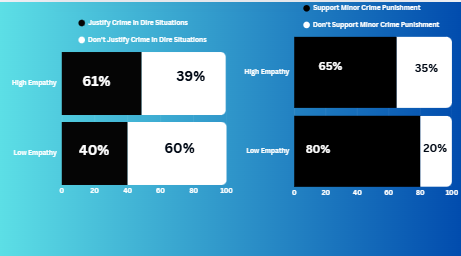
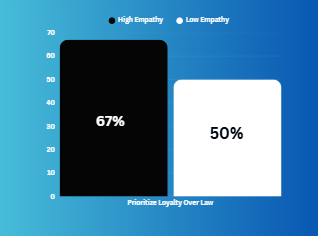
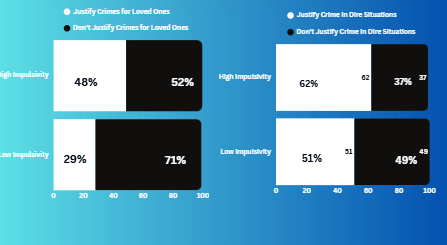
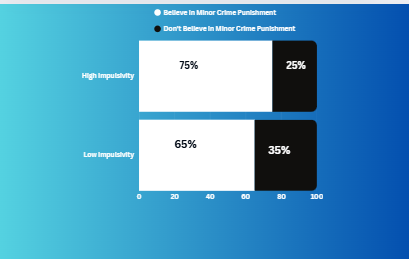

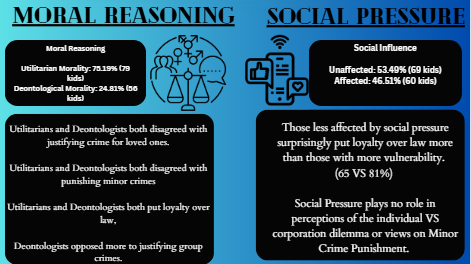
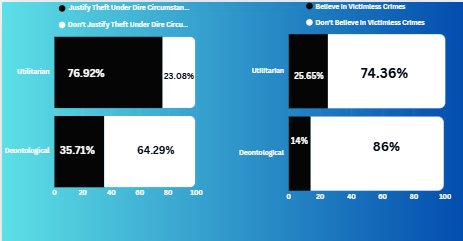
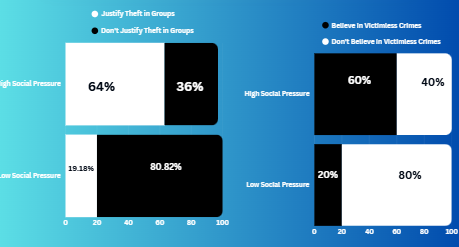

Conclusion
This project highlights the importance of understanding the psychological thinking behind any views or actions that are done. When you comprehend how they think, you can understand what they will do and how to help them through it. Empathy, Moral Reasoning, Impulsivity and Suceptibility to Peer Pressure all proved to play a role one way or another, whether through justifications of crimes, perceptions or accountability. Social Pressures proved the most effective, Morality the least- and points such as mental health, social media and effective counseling have been drawn! This is essential in order to understand what needs to be done to keep youth crime as low as possible, drawing towards a succesful future!!
Citations
Acknowledgement
A Sincere thanks to my teacher, Ms Sarvari, for blessing me with her astute advice and praise.
To all my classmates and online or in-person friends who helped me advertise my survey through social media platforms. I really needed it.
Thank you to Courtney Bailey, the community engagement coordinator who took the time to allow me to interview her.
And a major thank you to my Dad for as usual, consulting on my project, giving me advice, talking me through it and being my biggest supporter!!

